
Sison, officially the Municipality of Sison, is a municipality in the province of Pangasinan, Philippines. The town's original name was Alava. According to the 2020 census, it has a population of 52,320 people.

Pangasinan, officially the Province of Pangasinan, is a coastal province in the Philippines located in the Ilocos Region of Luzon. Its capital is Lingayen while San Carlos City is the most populous. Pangasinan is in the western area of Luzon along Lingayen Gulf and the South China Sea. It has a total land area of 5,451.01 square kilometres (2,104.65 sq mi). According to the 2020 census, it has a population of 3,163,190. The official number of registered voters in Pangasinan is 1,651,814. The western portion of the province is part of the homeland of the Sambal people, while the central and eastern portions are the homeland of the Pangasinan people. Due to ethnic migration, the Ilocano people settled in the province.

Bautista, officially the Municipality of Bautista, is a municipality in the province of Pangasinan, Philippines. According to the 2020 census, it has a population of 35,398 people.

Binalonan, officially the Municipality of Binalonan, is a municipality in the province of Pangasinan, Philippines. According to the 2020 census, it has a population of 56,382 people.

Bugallon, officially the Municipality of Bugallon, is a municipality in the province of Pangasinan, Philippines. According to the 2020 census, it has a population of 74,962 people.

Pozorrubio, officially the Municipality of Pozorrubio, is a municipality in the province of Pangasinan, Philippines. According to the 2020 census, it has a population of 74,729 people.

San Jacinto, officially the Municipality of San Jacinto, is a 4th class municipality in the province of Pangasinan, Philippines. According to the 2020 census, it has a population of 44,351 people.
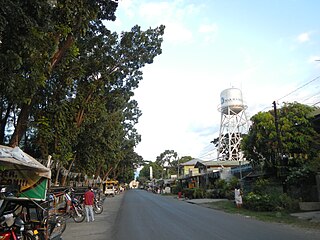
San Manuel, officially the Municipality of San Manuel, is a municipality in the province of Pangasinan, Philippines. According to the 2020 census, it has a population of 54,271 people.
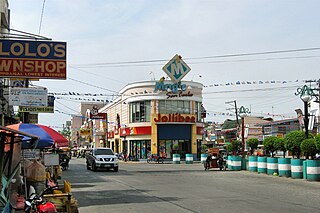
San Carlos, officially the City of San Carlos, is a component city in the province of Pangasinan, Philippines. According to the 2020 census, it has a population of 205,424 people. It is the most populated city in Pangasinan and the entire Ilocos Region.

The Roman Catholic Archdiocese of Lingayen–Dagupan is an archdiocese of the Roman Catholic Church in the Province of Pangasinan, Philippines. Its cathedral is the Metropolitan Cathedral of St. John the Evangelist in Dagupan with a co-cathedral, the Epiphany of Our Lord Parish Church, in the neighboring municipality of Lingayen.
The Palaris Revolt of 1762–1765 was led by Juan de la Cruz Palaris, also known as "Pantaleón Pérez", of Binalatongan, Pangasinan.

The Diocese of Laoag is a Latin Church ecclesiastical jurisdiction or diocese of the Catholic Church in the Philippines.

Saints Peter and Paul Parish Church, commonly known as Calasiao Church, is a Baroque church located in Poblacion West, Calasiao, Pangasinan, Philippines. It belongs to the Vicariate of Sts. Peter and Paul under the Ecclesiastical Province of the Roman Catholic Archdiocese of Lingayen-Dagupan. The 57,840 Catholics is under the pastoral care of Rev. Fidelis B. Layog, assisted by Rev. Isidro Palinar, Jr. and Rev. Raymund Manaois.

The Metropolitan Cathedral Parish of St. John the Evangelist, commonly known as Dagupan Cathedral, is located along Burgos Street in Dagupan, Pangasinan, Philippines. It is the cathedral of the Roman Catholic Archdiocese of Lingayen-Dagupan. Its titular head is Archbishop Socrates B. Villegas.
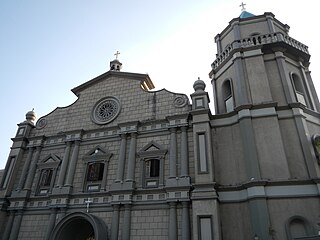
The Minor Basilica and Shrine Parish of Our Lady of the Rosary of Orani, commonly known as Orani Church, is a Roman Catholic minor basilica built in the Neoclassical style located in the center of Orani, Bataan, in the Philippines. It is under the jurisdiction of the Diocese of Balanga.

Saint Ildephonse of Seville Parish Church, commonly known as Malasiqui Church, is a Roman Catholic church in Malasiqui, Pangasinan in the Philippines. It is under the jurisdiction of the Archdiocese of Lingayen-Dagupan and was formerly a chapel under the parish of San Carlos. Father Juan Camacho was appointed first kura paroko and founded the parish in 1665. The 1660 Revolt caused the transfer from San Carlos to its present site at the town of Malasiqui in 1661–1662. The church celebrates its feast every January 23.
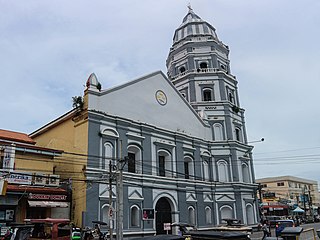
The Co-Cathedral Parish of the Epiphany of Our Lord, commonly known as Lingayen Church and formerly Los Tres Reyes or Three Kings Parish, is a historic Roman Catholic church and cathedral in Lingayen, Pangasinan in the Philippines. It is under the jurisdiction of the Archdiocese of Lingayen-Dagupan. The church is one of the oldest in the region, founded in 1587 in the same year Saint Dominic Basilica in San Carlos, Pangasinan was also founded. It is famous for its architecture, including a dome designed by Father Miguel Aparicio and its bell tower.
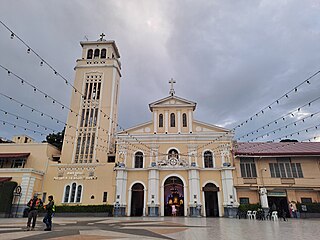
The Minor Basilica of Our Lady of the Rosary of Manaoag, commonly known as Manaoag Church, is a Roman Catholic minor basilica located in Manaoag, Pangasinan in the Philippines. It is under the jurisdiction of the Archdiocese of Lingayen-Dagupan. The shrine is dedicated to the Blessed Virgin Mary under the title of Our Lady of the Rosary. The original shrine was founded in 1600, it is administered by the Order of Preachers and is a popular tourist and pilgrimage site among devotees.

The Minor Basilica of Saint Dominic, formerly known as Saint Dominic Parish Church, is a Roman Catholic minor basilica located in San Carlos, Pangasinan in the Philippines. It is under the jurisdiction of the Archdiocese of Lingayen-Dagupan. The church, made out of bricks or ladrillo, used to be the largest Catholic church in the Philippines during the late 18th century, The church was finished in 1773, under the administration of Father Cristobal Ausina. However, it was destroyed by three earthquakes in 1789, 1796, and 1799.

Luyag na Caboloan, known simply as Caboloan, alternatively as Binalatongan, was a sovereign pre-colonial Philippine polity (panarian) situated near the Agno River delta, centered around Binalatongan. It was reportedly the largest settlement in the entire Pangasinan region.

























